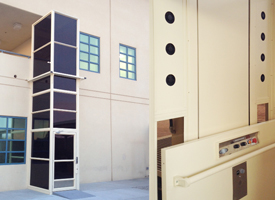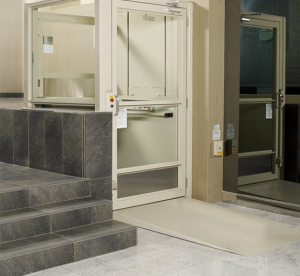 The Americans with Disabilities Act (ADA) continues to update its regulations, with the last major overhaul occurring in 2010. This legal document lists out all standards concerning accessibility, and within it are specifications for wheelchair lifts. Here are the most important points:
The Americans with Disabilities Act (ADA) continues to update its regulations, with the last major overhaul occurring in 2010. This legal document lists out all standards concerning accessibility, and within it are specifications for wheelchair lifts. Here are the most important points:
4.2.4
This section specifies that wheelchair lifts require at least a 30-inch by 48-inch space of clearance. In this area, the lift must be forward-facing or parallel to an object.
In providing a sufficient path, this area needs to either overlap with an accessible route or be adjacent to another area of clear floor space. If the lift is near an alcove or confined space, the building must provide additional moving clearance.
4.5
The ADA gives in detail what the ground and floor near the lift should look like, and this encompasses any nearby surface, such as a floor, walkway, ramp, stairway, or curb. Specifically, all must provide a stable, firm, and slip-resistant area for the wheelchair.
Furthermore, if the floor changes in level, the ADA lists what, exactly, the building needs to provide for accommodations:
- Up to a ¼” gap – No edge treatments are needed.
- If between ¼” and ½” – A beveled edge must accompany the change.
- If above ½” – A ramp must be installed.
 The ADA, too, covers carpeting in this section. Any material used needs to be fastened at the edges and have no piling or thickness greater than ½”. Any exposed edges must also be sufficiently trimmed.
The ADA, too, covers carpeting in this section. Any material used needs to be fastened at the edges and have no piling or thickness greater than ½”. Any exposed edges must also be sufficiently trimmed.
Along with these points, section 4.5 touches on grating. Buildings cannot have spaces greater than ½” wide in a single direction. If these run along the length, they must be perpendicular to the wheelchair’s travel direction in moving toward the lift.
4.27
If your building has electrical and communication equipment on the wall that’s designed for public use, it cannot be mounted under 15 inches from the floor. For those with disabilities, this equipment needs to have easy one-hand operation without tight grasping, pinching, or twisting required.
4.1.3
The ADA states platform lifts may be used in place of an elevator, under the following conditions:
- The lift gives access to an area for assembly occupancy, or used by a large group.
- It provides access to incidental occupiable spaces, such as rooms not open to the general public.
- It provides access when an elevator or ramp isn’t practical.
- To comply with wheelchair viewing line-of-site and dispersion requirements.
Looking for a compliant commercial solution? To learn more, contact Apex Wheelchair Lifts to discuss our range of models.
OUR PRODUCTS
About Our Products
- Electric Wheelchair Lifts
- Handicapped Wheelchair Lift
- Handicapped Wheelchair Lifts
- Handicap Wheelchair Lift
- Handicap Wheelchair Lifts
- Home Wheelchair Lift
- Home Wheelchair Lifts
- Lifts for Wheelchairs
- Outdoor Wheelchair Lifts
- Platform Lifts
- Platform Wheelchair Lift
- Platform Wheelchair Lifts
- Power Wheelchair Lifts
- Wheelchair Lift
- Wheelchair Lifts
- Wheelchair Lifts for Stairs
- Wheelchair Lift Cost
- Wheel Chair Lift
- Wheel Chair Lifts
- Wheelchair Stair Lift
- Wheel Chair Stair Lift
Tips and Information
- A Wheelchair Lift or Ramp?: The Pros and Cons
- All You Need to Know About Vertical Wheelchair Lifts
- Can An Inclined Wheelchair Lift Work in a Home?
- Cleaning a Wheelchair Lift
- Designing a Custom Wheelchair Lift
- Differences between Vertical and Inclined Wheelchair Lifts
- Different Types of Wheelchair Lifts
- Does a Wheelchair Lift Work Outdoors?
- Do You Need a Multi-Story Wheelchair Lift?
- Finding the Right Inclined Wheelchair Lift
- Five Tips for Installing Inclined and Vertical Wheelchair Lifts
- Getting the Most Out of Your Wheelchair Lift
- Guidelines for Vertical Platform Lifts
- How Are Curved Platform Lifts Designed?
- How a Wheelchair Lift Benefits a Small Business
- How Does a Curved Platform Lift Work?
- How Does a Platform Wheelchair Lift Work?
- How Does an Inclined Platform Lift Operate?
- How Far Can a Wheelchair Lift Travel?
- How Fast Can a Wheelchair Lift Travel?
- How is a Custom Wheelchair Lift Created?
- How is a Wheelchair Lift Installed?
- How Much Does a Wheelchair Lift Cost?
- How to be ADA Compliant With a Wheelchair Lift
- How to Incorporate Wheelchair Lifts into a Multistory Building
- How to Maintain a Wheelchair Lift
- Installing an Outdoor Wheelchair Lift
- Insurance for Wheelchair Lifts and Stair Lifts
- Is an Inclined or Vertical Wheelchair Lift Better for your Building?
- Maintaining a Safe Wheelchair Lift
- Operating a Wheelchair lift
- Places for Installing a Wheelchair Lift in Homes & Commercial Areas
- Preparing Your Home for a Wheelchair Lift
- Safety Features for Wheelchair Lifts
- Safety Tips for Using Wheelchair Lifts
- Standard Wheelchair Lift Features
- The Business Benefits of Wheelchair Lifts
- The 9 Key Components of a Vertical Platform Lift
- The Most Important ADA Regulations for Platform Lifts
- The Travel Distances of a Wheelchair Lift
- The Wheelchair Lift Installation Process
- Three Tips for Selecting a Vertical Wheelchair Lift
- Tips for Businesses Accommodating Individuals with Disabilities
- Tips for Installing a Vertical Wheelchair Lift
- Understanding a Hydraulic Wheelchair Lift
- Using a Wheelchair Lift to Transport Heavy Items
- What’s the Difference between a Screw Drive and a Hydraulic Drive?
- What Are the Advantages of the Apex Complete Wheelchair Lift?
- What are the Basic Parts of a Vertical Wheelchair Lift?
- What Are the Wheelchair Lift Options for a Smaller Home?
- What a Business Needs to Know before Installing a Wheelchair Lift
- What is a Multi-level Inclined Wheelchair Lift?
- What Powers an Inclined Wheelchair Lift?
- Wheelchair Lift Costs
- Wheelchair Lift Inspections
- Wheelchair Lifts & Safety
- Why A Wheelchair Lift?
- Wheel Chair Lifts for Curved Staircases
- When does a Commercial Building need a Wheelchair Lift?
- Where Should You Install a Wheelchair Lift?
- Will a Wheelchair Lift Change Your Business Insurance?
- Will a Wheelchair Lift Work for a Small Business?
- Will Your Home Support a Wheelchair Lift?
